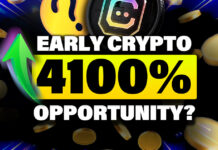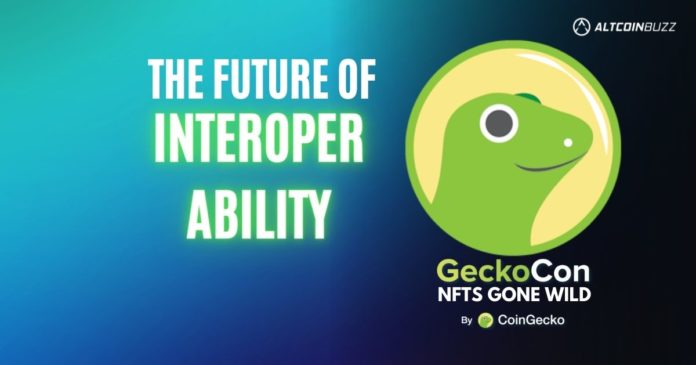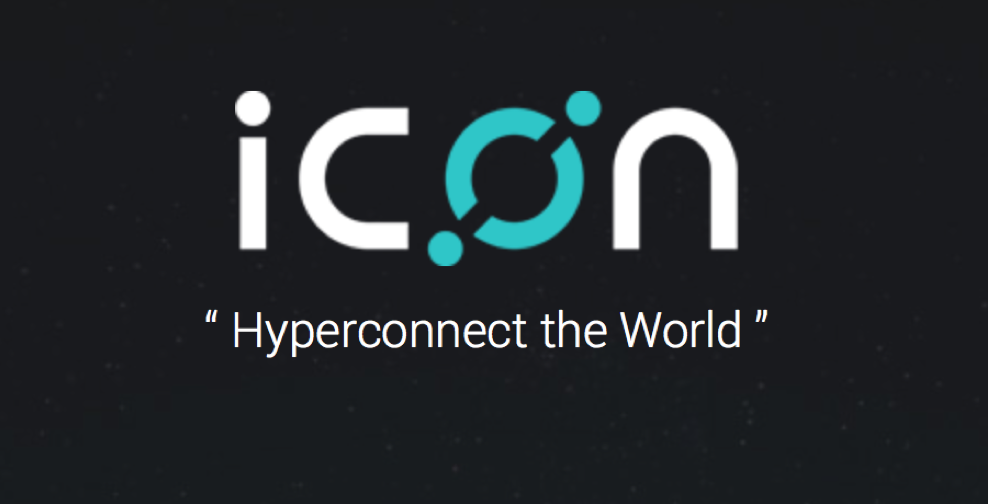Blockchain interoperability is a hot item. Different blockchains can interact with each other. A multi-chain future seems inevitable, where bridges between chains are important. However, we also know that bridges are vulnerable.
The panel on ‘The Future of Interoperability’ consists of:
- Wei Shi Khai—Moderator. General Partner and COO at LongHash Ventures.
- Chase Morgan—Core Contributor at Wormhole.
- Kevin Beardsley—COO at XDEFI Wallet.
- Vaibhav Chellani—Co-founder and bridge builder at Socket.
- Ahmed Al-Balaghi—Co-founder at Biconomy.
Source: GeckoCon 2022
What Will the Big Picture of Interoperability Look Like?
The consensus is that devs and users don’t know on which blockchain they are. In short, everything will be seamlessly integrated. A user will find himself where the volume is high, and the gas fees are low. For both, the bridges will manage the state and assets. They will move them along.
Cross-chain networks can live across many chains instead of living on one. That’s how it is right now.
We Just Started Today With Interoperability, so Where Are We Right Now?
Chase gave an explanation and background on the Wormhole. It’s now an asset bridge, and not only for tokens. Security is important since we saw bridge hacks. Recently, for instance, Ronin and Harmony. In February 2022, also Wormhole. All bridge hacks are smart contracts and owner permission-based.
However, chains talk in different ways to each other. For security, they use different options. For instance, guardians at Wormhole, or other methods. They also need to address various security assumptions in a good way for security. In particular, liveness and other trust assumptions. That’s the core assumption at the base layer. It’s secure, it works, and is live all the time.
Today, we have many L1 Blockchains like $BTC, $ETH, $SOL, $AVAX etc. Users might have multiple assets across multiple chains, but they will not be able to leverage them across all chains. Moving assets across chains is tough. Here's how bridges solve for interoperability👇🧵
— Vatsal Kanakiya (@vazzupk) July 16, 2022
How Do We Build Apps That Make Use of This Interchain Communication?
Vaibhav gives a sample of how they achieved this at Socket. He worked with many L2 and build the first ZK-Rollup at Polygon. After that, he got involved with optimistic rollups at Ethereum. He saw a pattern between all these L2s and sidechains, and he sees them now as bridges. As a result, they build a stack with various security layers at Socket. They use modules for this. So, for example, they have data or exhibition layers. This way, you can change the security levels. For devs, it’s now easy to use.
How Can We Create a Better Experience for the End User?
Kevin gives his XDeFi wallet as a sample. For instance, MetaMask works only on one chain, Ethereum. However, for DeFi users, it’s hard to have 5-6 different extensions. This allows them to access 5-6 different blockchains. So, they aggregated blockchain frameworks. They show them in one single display.
Currently, they already integrated 14 blockchains. They also boast over 100,000 users. Their next step is native token support. Currently, only with THORChain. However, more are to follow, with Wormhole, ParaSwap, and 1inch. This gives users access to over 80% of all coins on CoinGecko. Furthermore, they added NFTs. All NFTs from various blockchains display in a single panel. They want to abstract away the concept of blockchains for users.
How Can We Get to the Concept of Multiple Cross Chains?
Ahmed talks from the Biconomi perspective. They started to abstract away the gas fees from end users. To reach mass adoption, it’s a no-brainer that devs subsidize gas fees. So, to achieve this, they build Hyphen, a liquidity layer. As a result, they have various liquidity pools across 6 blockchains. End users can change their funds between pools within 10-20 seconds.
Their goal is to build tools that make the lives of devs easier and simpler. So, this allows them to utilize different companies and projects.
Are We Mitigating Trust and Security Risks to Achieve These Goals?
The Harmony bridge hack was a Web 2 exploit. So, it’s not only the basics of smart contracts. It’s also the Web 2 infrastructure, audits, etc. At Biconomi they test everything to the max with serious stress tests. They can’t deploy otherwise. Eventually, they want to abolish all trust assumptions. The future should see no single trust dependency. This will avoid exploits like Harmony. The industry should come together and share best practices.
Crypto Bridges 🌉 solve one of the fundamental problems of blockchains: #INTEROPERABILITY ✅
However, theft from cross-chain bridges totaled more than $1 BILLION in 2022Here's a thread that will help you understand the RISKS
associated with cross-chain bridges:— Momentum 6 (@Momentum_6) July 18, 2022
What Else Do We Need to Move Forward?
- Chase; Some problems we can solve with engineering. Other issues are regulatory or political. We should keep our solutions decentralized. He expects the current tradeoffs to going away in the future.
- Kevin; If you have questions about DeFi, join the various Discord groups. People are helpful and friendly.
- Ahmed; Check out the Biconomi rewards platform. Do some quests and get free tokens.
- Vaibhav; Invites you to join their framework and start planning things together.
Conclusion
This was a really interesting discussion. The panel expects a great future for interoperability. The plans and solutions they present are very exciting indeed. For example, seamless transfers between blockchains without gas fees. I can’t wait for this to happen.
⬆️For more cryptocurrency news, check out the Altcoin Buzz YouTube channel.
⬆️Find the most undervalued gems, up-to-date research, and NFT buys with Altcoin Buzz Access. Join us for $99 per month now.




























